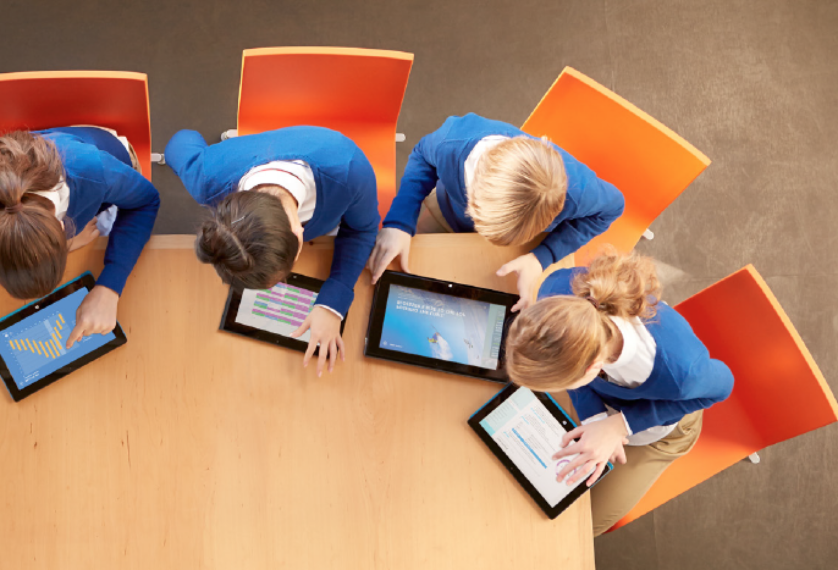Posted on 04.08.2015

Mobile devices are increasingly becoming teaching tools, from pre-school to graduate.
A recent survey by the Pew Research Center, USA found that 58% of American teachers have smartphones – 10% more than the national average for adults. The teachers are embracing the type policies “bring your own device” in classes and asking that schools have to offer and tablets for their students.
- Air classroom affect learning?
But what these mobile devices really add to school? This technological trend goes beyond grabbing the attention of students or is it just an eye-catching way to achieve the same goals possible with analog instruction?
The benefits of mobile technology
The research Pew Research Center asked a group of teachers to examine the educational impact of technology in the classroom. They found that:
- 73% of teachers use mobile technology in their classrooms, either through their own instruction or allowing students to use devices to complete the tasks;
- English Teachers are more likely to use mobile technology in the classroom than mathematics teachers;
- 47% of teachers strongly agree and an additional 44% somewhat agree that students need digital literacy courses to be successful academically and beyond.
Other research also viewed advantages. The company PBS Kids, in partnership with the US Department of Education found that the vocabulary of children aged between 3 and 7 years who used the application “Martha Speaks” improved by 31%.
Abilene Christian University conducted a survey at the same time finding that math students who used the app “Statistics 1″ saw improvement in their final grades. They also felt more motivated to finish classes on mobile than through traditional textbooks devices.
- Confusion can help in learning
In addition, more one study found that 35% of 8th graders felt more interested in their lessons or activities when used tablet, and in general exceeded the academic expectations of teachers to use the devices. 54% of pupils said they get more involved in the lessons that use technology and 55% said they would like their more educational games or simulations wear teachers to teach lessons.
Cons
Next the benefits, mobile devices certainly come with its share of complications. The teacher’s authority, for example, is an area that can easily be called into question when mobile technology is permitted in classrooms.
There is also the issue of cost. Of course there is a price associated with technology. And even if the children can bring their own devices, will still be the problem of disparity -. Of course, some students are more privileged than others, which can cause various difficulties
Technology Policies also are more difficult to implement in personal electronic devices than on school property devices – the latter may come with certain pre-installed programs and not allow any activity that has nothing to do with learning. A device that goes home with the student, however, may not have the same rules.
There are also privacy issues to consider. Do we want the 3rd following our students in their learning pathways? And teachers should have access to what students do on their mobile devices when out of the classroom?
- TV, video games and cell phone by the bed children do lose sleep and go worse at school
Mobile Technology in the classroom: What Works
As mobile technology in the classroom does not guarantee an increase in understanding or even attention? students. So what types of mobile technology use make more sense for learning
In summary:
- E-readers: part of the problem with traditional textbooks is that they are quickly outdated. E-readers eliminate this problem and allow real-time updates that are useful for students and teachers;
- individual mobile modules: educational apps and games are options that can be thought individually to students. This gives them an opportunity to work at their own pace, taking extra time in areas where most need;
- Response Programs in text message: sites that allow teachers send homework or tests with questions for students via text result in a more interactive approach to learning. Most programs that facilitate this technology allow for real-time feedback, giving students the chance to learn from your mistakes and put everything in context. Students also become more motivated to go to school and complete a task when they have access to text messages from their teachers;
- cloud Learning: Using mobile technology that is connected to a cloud means that Students can do the task of transition in the classroom for the task at home – or anywhere else – easily, provided they have access to a smartphone, tablet or computer. This saves time and improves organizational skills of the students.
- The 11 most amazing schools in the world
Conclusion
The mobile learning can actually make a positive difference in how students instruct themselves. When used properly, has the potential to help students learn and become more involved.
But the devices are not salvation. Competent teachers are as necessary as the technology in the Information Age, to balance the mobile educational advantages with healthy interaction in order to maximize the value of both. [Gizmodo]

No comments:
Post a Comment